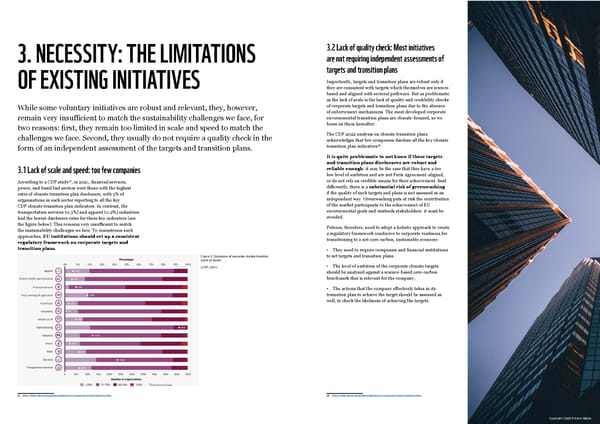17 3. NECESSITY: THE LIMITATIONS OF EXISTING INITIATIVES While some voluntary initiatives are robust and relevant, they, however, remain very insufficient to match the sustainability challenges we face, for two reasons: first, they remain too limited in scale and speed to match the challenges we face. Second, they usually do not require a quality check in the form of an independent assessment of the targets and transition plans. 37 https://www.cdp.net/en/guidance/guidance-for-companies/climate-transition-plans . 3.1 Lack of scale and speed: too few companies According to a CDP study 37 , in 2021, financial services, power, and fossil fuel sectors were those with the highest rates of climate transition plan disclosure, with 5% of organisations in each sector reporting to all the key CDP climate transition plan indicators. In contrast, the transportation services (0.3%) and apparel (0.2%) industries had the lowest disclosure rates for these key indicators (see the figure below). This remains very insufficient to match the sustainability challenges we face. To mainstream such approaches, EU institutions should set up a consistent regulatory framework on corporate targets and transition plans. Figure 3: Disclosure of corporate climate transition plans by sector (CDP, 2021) 3.2 Lack of quality check: Most initiatives are not requiring independent assessments of targets and transition plans Importantly, targets and transition plans are robust only if they are consistent with targets which themselves are science- based and aligned with sectoral pathways. But as problematic as the lack of scale is the lack of quality and credibility checks of corporate targets and transition plans due to the absence of enforcement mechanisms. The most developed corporate environmental transition plans are climate-focused, so we focus on them hereafter: The CDP 2022 analysis on climate transition plans acknowledges that few companies disclose all the key climate transition plan indicators 38 . It is quite problematic to not know if these targets and transition plans disclosures are robust and reliable enough : it may be the case that they have a too low level of ambition and are not Paris Agreement-aligned, or do not rely on credible means for their achievement. Said differently, there is a substantial risk of greenwashing if the quality of such targets and plans is not assessed in an independent way. Greenwashing puts at risk the contribution of the market participants to the achievement of EU environmental goals and misleads stakeholders: it must be avoided. Policies, therefore, need to adopt a holistic approach to create a regulatory framework conducive to corporate readiness for transitioning to a net-zero carbon, sustainable economy: • They need to require companies and financial institutions to set targets and transition plans; • The level of ambition of the corporate climate targets should be analysed against a science-based zero-carbon benchmark that is relevant for the company; • The actions that the company effectively takes in its transition plan to achieve the target should be assessed as well, to check the likeliness of achieving the targets. 38 https://www.cdp.net/en/guidance/guidance-for-companies/climate-transition-plans. Copyright Credit © Kevin Matos
 Corporate Sustainability & Transition Plans Page 8 Page 10
Corporate Sustainability & Transition Plans Page 8 Page 10